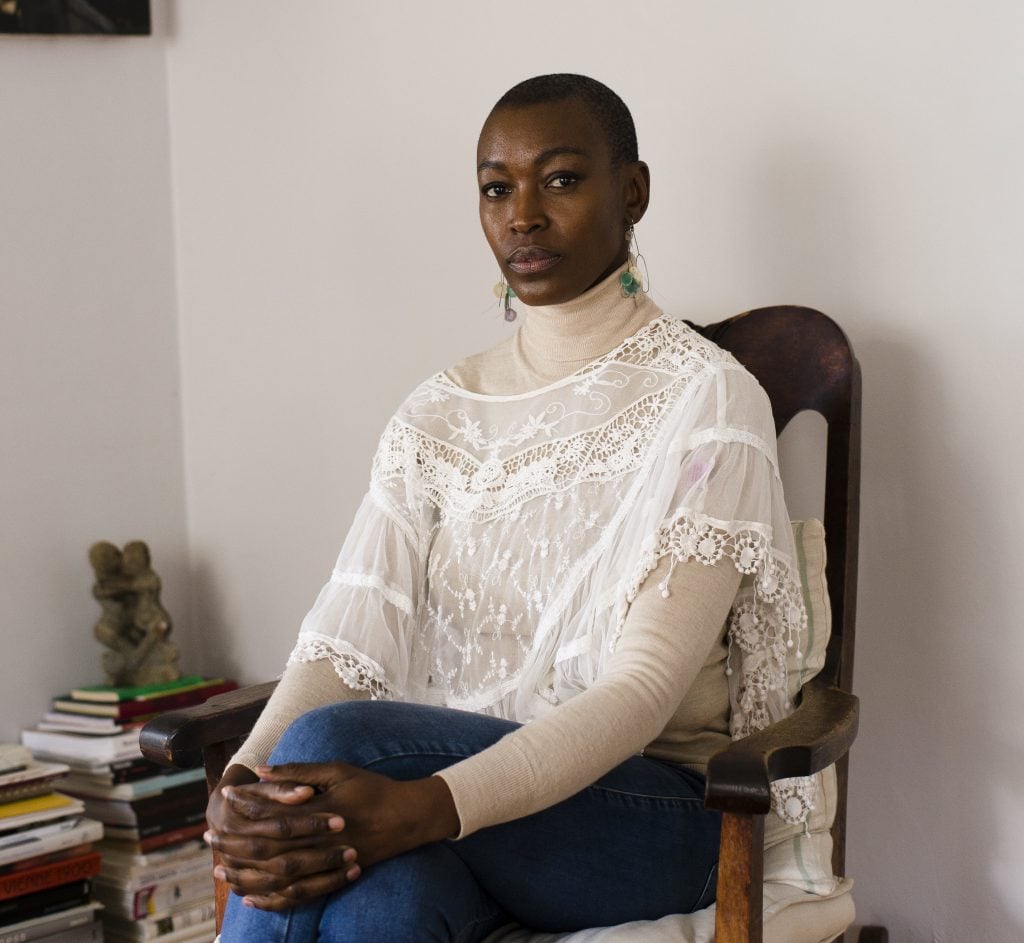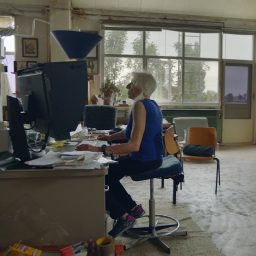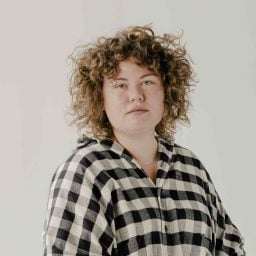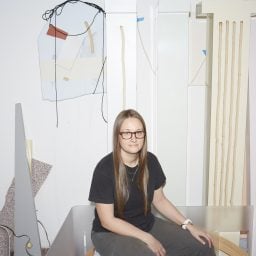Johannesburg-based Malawian artist Billie Zangewa—an on-the-rise textile creator—is best known for her powerful collages depicting scenes of domestic life in hand-stitched scraps of silk. She found lockdown, which forced her to spend extra time at home, logical fodder for her latest body of work.
Seven new works documenting scenes of sheltering-in-place comprise her debut exhibition with New York’s Lehmann Maupin, which opened this week (through November 7). The show, titled “Wings of Change,” riffs on themes of loss, mourning, and apathy, as well as love, personal transformation, deepening relationships, and hope.
It’s a show that Zangewa hopes will ultimately capture the bittersweetness of our collective slowdown. Ahead of the opening, the artist spoke to Artnet News about art-making through mess, her undying love of sushi, and finding inspiration in the mundane.
What are the most indispensable items in your studio and why?
My very old Canon Powershot camera that I got in New York in 2009 when I was there for a residency with the Bronx Museum. Friends look at me strangely when I pull it out, but it has a self-timer, which is very useful when I take my research photos. Also, I believe that there is enough waste in the world and I’m doing my bit for the environment in a small way.
My MacBook Air, from which everything happens—I download my research photos on it, and it’s great for when I need to zoom in on details. I’m close to my emails if there’s anything urgent that needs my attention. It gives me flexibility and versatility.
Lastly, my thimble. It’s hard to get used to using one, but it’s invaluable when I’m working intensely. An ex of mine got it for me on a business trip to Vienna, and it’s really beautiful.
What is the studio task on your agenda tomorrow that you are most looking forward to?
I look forward to organizing the mess that I inevitably make when I’m working. There is something really satisfying about organizing things and seeing them all neat and tidy; it kind of reminds me of when my son was a toddler. He’d mess up his playroom and I’d come along and tidy it all up again. When he saw it tidy like that, he got so excited he started to make a mess again. I think he thought it was a game!
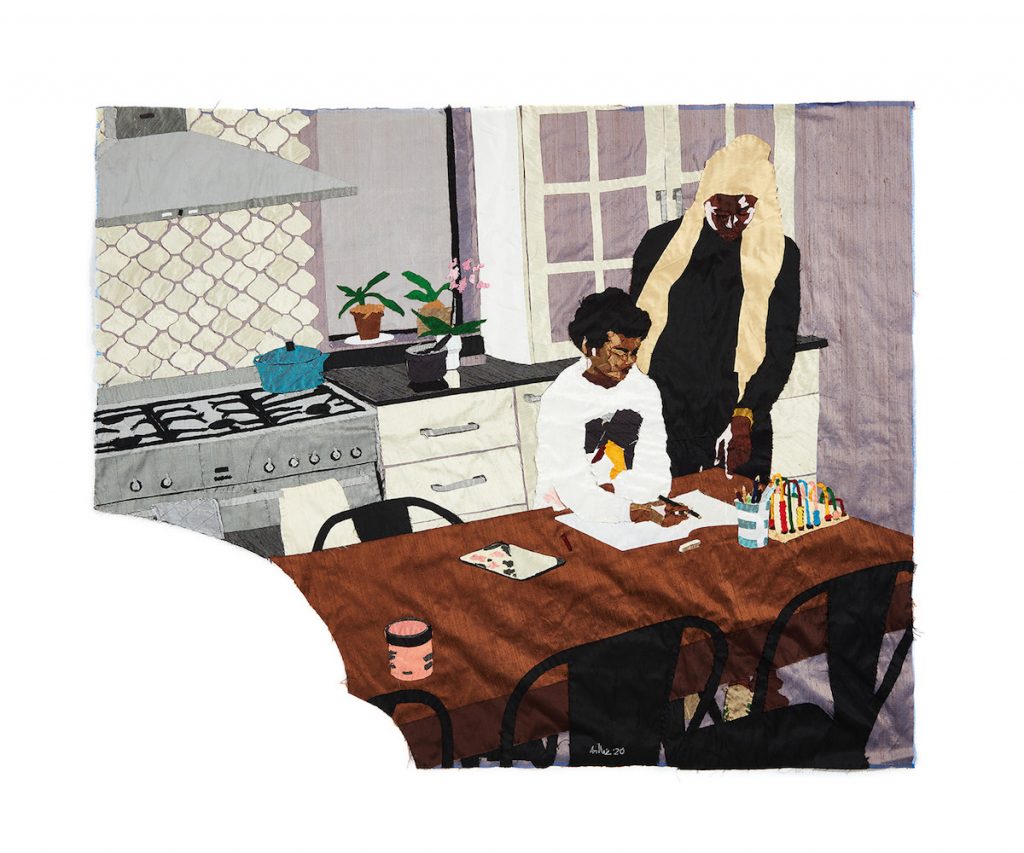
Billie Zangewa, Heart of the Home (2020). Photo courtesy Lehmann Maupin and the artist.
You have a show coming up this week. What can people expect to see?
People can expect to see very relatable images derived from my daily life during the lockdown experience. I’m addressing different aspects of it through the lens of the daily obligations that I’ve had to take on and adapt to, like homeschooling and cleaning the house. They will see the surreal new tint that the everyday has taken on. During lockdown, the usual mundane tasks did feel somehow strange, the threat of an invisible enemy ever present. There are themes of newfound appreciation, joy, and loss.
What I really want people to walk away with is the feeling of hope; that despite the challenges that we’ve all faced and are still facing, life is worth living. That is why I called the show “Wings of Change”—to imply hope in the face of adversity, as opposed to “winds of change,” which to me just implies chaos.
What kind of atmosphere do you prefer when you work? Do you listen to music or podcasts, or do you prefer silence?
I listen to music. Mainly radio—Radio Nova, a French station based in Paris, to be specific. They play music of different genres from around the world, and I really love that. My favorite song I listened to while working on the show was Nada by Lido Pimiento, a singer from Colombia. I don’t speak Spanish, but I found the song so emotive and could relate to that aspect of it, which requires no translation. I watched the music video and it added so much more to my understanding of her message. It’s a really stunning work of art, both the song and the video.
I find silence while I’m working to be very distracting. Sometimes I put on a TV series just to have that background noise. I think the feeling stems from my childhood—while my family would play after-dinner games and watch TV, I would draw. The background noise was very comforting.
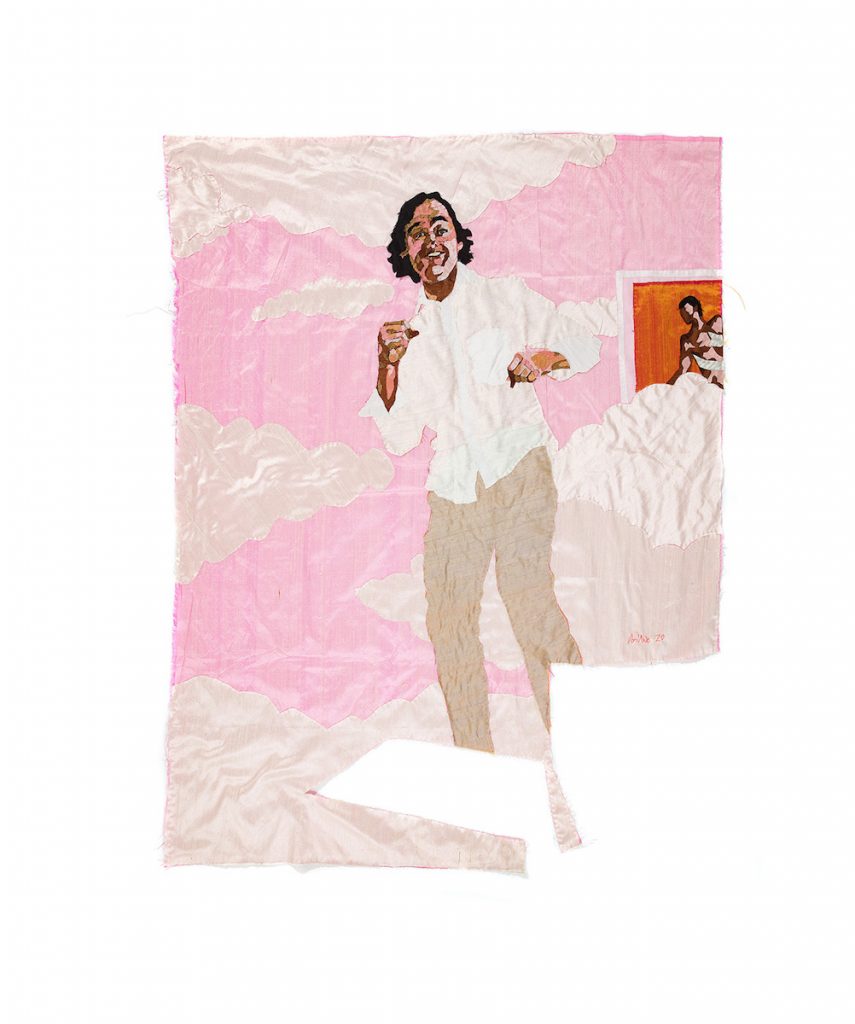
Billie Zangewa, Free Spirit (2020). Photo courtesy Lehmann Maupin and the artist.
What trait do you most admire in a work of art? What trait do you most despise?
I admire so many different qualities: honesty, vulnerability, and of course, aesthetics. Beauty is an important component. For me personally, as someone who is not word-based, if a work has too much text attached, I feel tired by it. I like there to be room for a spontaneous emotional reaction without all of the information.
Sometimes, a work needs to grow on me—a bit like sushi did. The first time I tasted it, it was like the shock of the new for my taste buds. The second time I had it, I was hooked. I had a similar experience with Yayoi Kusama’s dot paintings. I didn’t get them initially and now I’m potentially her biggest fan. Come to think of it, maybe I could get used to long explanations of artworks as well.
What snack food could your studio not function without?
I don’t really snack, to be honest. I eat three meals a day, and on the odd occasion I have the urge to snack, my go-tos are dried mango, fresh fruit, and—a very bad weakness of mine, which I try to avoid since it goes straight to the hips—what we call crisps. They just tick all the boxes— crunchy, salty with a bit of sweet, full of trans fats…
Who are your favorite artists, curators, or other thinkers to follow on social media right now?
Being a single parent doesn’t leave that much time for social media. But if I had the time, I’d follow Kusama, whom I’ll love eternally; El Anatsui, whose work is beyond amazing; young artists like photographer Lebohang Kganye; Kerry James Marshall, who gave me another view of depicting Blackness; and Chimamanda Ngozi Adichie, for her sheer brilliance. Every novel I’ve read of hers has been arresting.
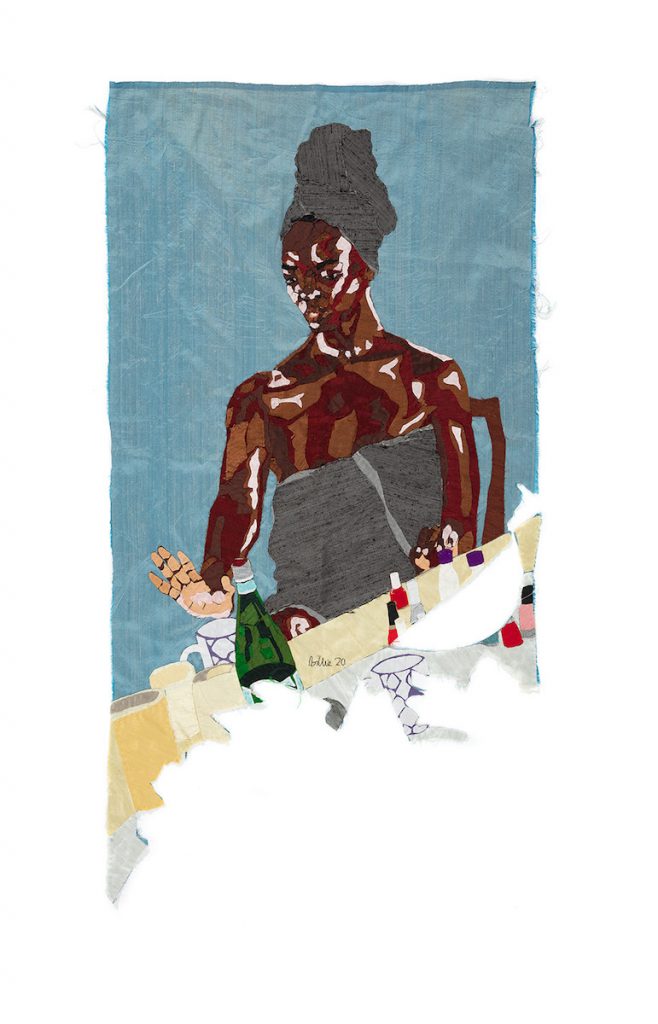
Billie Zangewa, Self-Care Sunday (2020). Photo courtesy Lehmann Maupin and the artist.
When you feel stuck in the studio, what do you do to get un-stuck?
I engage in mundane tasks like doing laundry—any kind of distraction. I used to move furniture around but that has lost its charm. I like to take walks and bake tarts for my son. I take long baths—not environmentally sound, I know, but water is so transformative. I also page through interior design magazines and revisit old issues of Vogue. I find listening to [the late American motivational speaker] Louise Hay very soothing; her affirmations grounding. If I get stuck in the middle of a work, I usually put it aside and work on something else. I also find the midnight hour to be very magical. Often clarity comes to me at that time, so that’s usually when I do my problem-solving.
What is the last exhibition you saw (virtual or otherwise) that made an impression on you?
South African artist Thenjiwe Niki Nkosi’s “Gymnasium,” which I viewed online at the very beginning of the lockdown. There is a kind of quiet cinematic quality to the paintings that I found very touching. Viewing them felt like watching a film with the sound turned off.
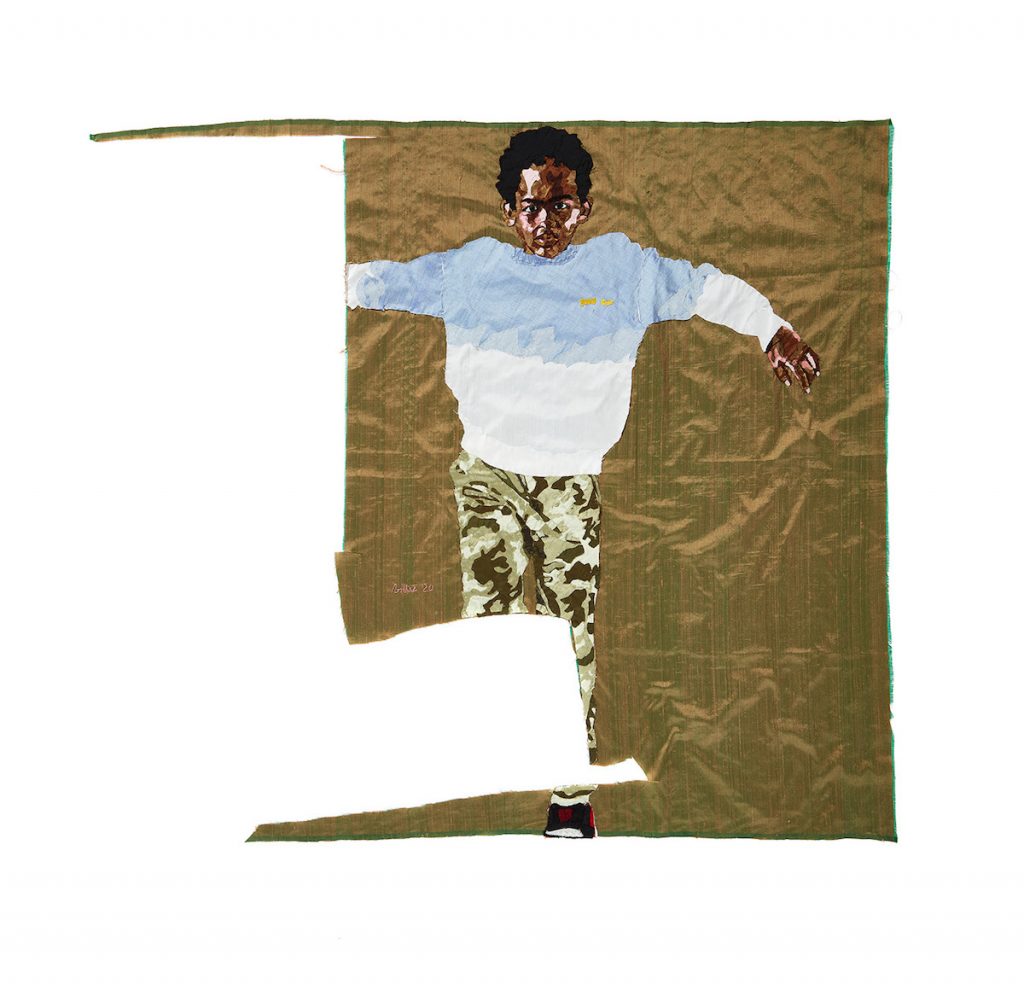
Billie Zangewa, Everyday Miracle (2020). Photo courtesy Lehmann Maupin and the artist.
If you had to put together a mood board, what would be on it right now?
There would be the sea, which is always a force I yearn for. The Wild Coast in South Africa is particularly beautiful. My son, as I can’t conceive of anything without thinking of him; it’s a love affair, and I love him simply because he exists. Anything in emerald green, delicious Japanese food, and really cool, innovative tie-dye. I’d also have a photo of a Tuareg man as I find them so mysterious, slightly dangerous, and very attractive. A Berber village in the Atlas Mountains of Morocco to remind me of some of the most memorable trips I’ve ever taken. As a lover of fashion, I’d also have anything by Issey Miyake or Dries Van Noten—or maybe both! I am also obsessed with stones and at the moment, I’m loving black onyx.
